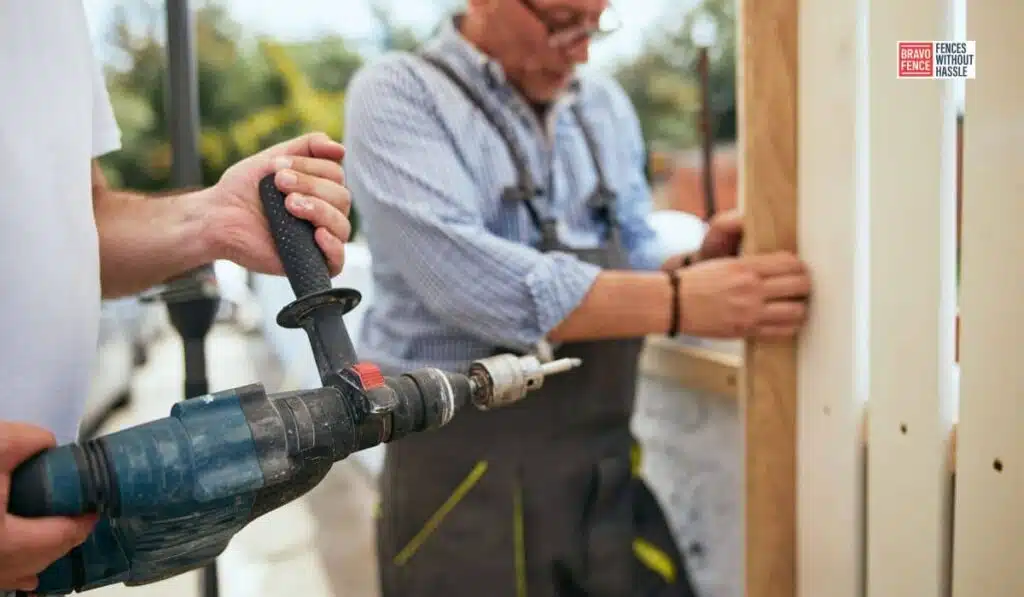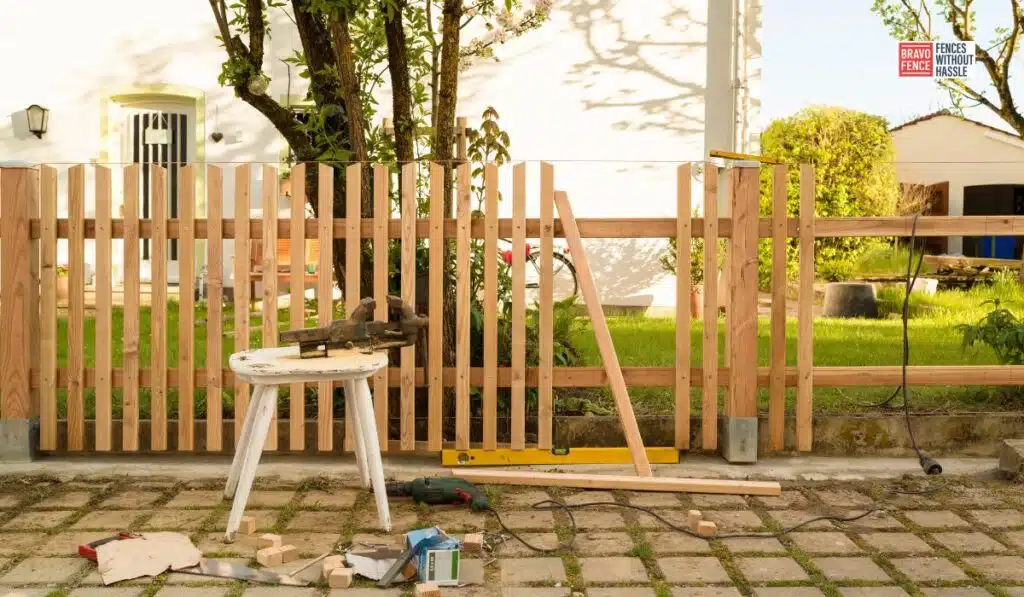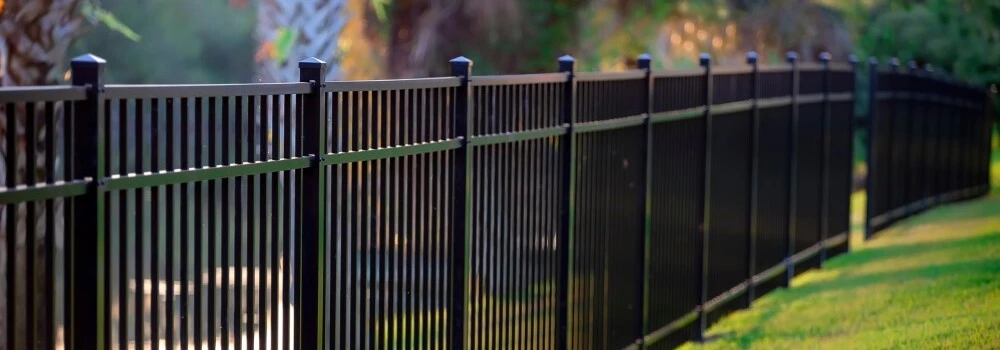
Wood Fence Repair: Common Issues and Solutions
Wood fences are a popular choice for homeowners due to their natural beauty, versatility, and affordability.
However, like any outdoor structure, they are subject to wear and tear over time.
From rotting posts to loose boards, wood fences can develop various issues that require prompt attention to prevent further damage.
In this article, we’ll explore some common problems encountered with wood fences and provide practical solutions for repair.
Rotting Wood:
One of the most prevalent issues with wood fences is rotting.
This can occur due to prolonged exposure to moisture, such as rain or sprinkler systems.
Rot typically affects the bottom portion of fence posts, where they come into contact with the soil.
Signs of rot include soft or crumbling wood, discoloration, and an earthy odor.
Solution: To repair rotting wood, start by assessing the extent of the damage.
If only a tiny portion of the post is affected, you may be able to remove the rotted area using a chisel or saw and fill the cavity with wood filler.
However, if the rot is extensive, it’s best to replace the entire post. Dig around the post to expose the base, then remove it and install a new post, ensuring it’s properly treated to resist moisture and decay.
Loose or Missing Boards:
Another common issue with wood fences is loose or missing boards.
These can compromise the fence’s structural integrity and diminish its appearance.
Loose boards may result from warping, expansion, and contraction due to temperature changes or deteriorating fasteners.
Solution: For loose boards, start by tightening any loose screws or nails holding them in place.
If the boards are warped, you may need to replace them with new ones.

When replacing missing boards, make sure to choose lumber that matches the existing fence.
Use corrosion-resistant screws or nails to secure the latest boards in place, ensuring they’re evenly spaced for a uniform appearance.
Leaning or Tilting Fence:
Over time, wood fences may start to lean or tilt, especially if the posts need to be correctly installed or if the soil has shifted beneath them.
This can compromise the fence’s stability and pose safety hazards.
Solution: To address a leaning or tilting fence, start by inspecting the posts for signs of damage or instability.
If the posts are still structurally sound, you can reinforce them by adding braces or support brackets.
Alternatively, you can reset the posts by digging out the soil around them, straightening them, and adding fresh concrete for stability.
Ensure the posts are plumb and level before allowing the concrete to set.
Mold and Mildew:
Wood fences in damp or shaded areas are prone to mold and mildew growth, which can detract from their appearance and weaken the wood over time.
Solution: To remove mold and mildew from a wood fence, start by scrubbing the affected areas with a solution of mild detergent and water.
For stubborn stains, you can use a bleach solution (1 part bleach to 4 parts water), but be sure to wear protective gear and rinse the fence thoroughly afterward.
Once clean, consider applying a waterproofing sealant or stain to protect the wood and prevent future growth.
Insect Infestation:
Wood fences are also susceptible to insect infestations, particularly by termites and carpenter ants.
These pests can tunnel through the wood, causing structural damage and compromising the integrity of the fence.
Solution: To prevent insect infestations, consider treating the wood with a termite-resistant solution before installation.
Additionally, regularly inspect the fence for signs of insect activity, such as small holes or sawdust-like debris.
If an infestation is detected, consult with a professional exterminator to determine the best course of action, which may include treating the affected areas with insecticides or replacing damaged sections of the fence.
Fading and Weathering:
Exposure to sunlight, rain, and other environmental factors can cause wood fences to fade and weather over time, diminishing their appearance and reducing their lifespan.
Solution: To protect against fading and weathering, consider applying a UV-resistant sealant or stain to the wood every few years.
This will help to maintain the natural color and integrity of the wood while providing an additional barrier against the elements.
Regularly cleaning the fence and removing debris can also help to prolong its lifespan and keep it looking its best.
Fence Post Movement:
In areas with expansive soils or fluctuating temperatures, fence posts may move or shift over time, leading to gaps between them and the fence panels.
Solution: To address fence post movement, consider installing post anchors or braces to provide additional support and stability.
Alternatively, you can reinforce the posts with gravel or concrete footings to prevent shifting.
Regularly inspecting the fence and adjusting the supports as needed can help maintain its structural integrity and prevent further movement.
Warping and Cupping:
Wood fences may also experience warping and cupping, especially in regions with high humidity or fluctuating moisture levels.
This can result in uneven surfaces and gaps between the boards.
Solution: To minimize warping and cupping, choose high-quality, kiln-dried lumber for your fence construction.

Properly seal or stain the wood to protect against moisture absorption, and ensure adequate spacing between the boards to allow for expansion and contraction.
If warping or cupping occurs, you may need to replace the affected boards to restore the fence’s appearance and functionality.
Conclusion
Wood fences require regular maintenance and occasional repairs to withstand the elements and remain in good condition.
By addressing common issues such as insect infestations, fading, fence post movement, and warping in a timely manner, homeowners can prolong the life of their wood fences and enjoy the many benefits they provide.
With proper care and attention, a well-maintained wood fence can enhance the beauty, privacy, and security of any property for years to come.
For professional assistance with wood fence repair or installation, contact us at Bravo Fence Company.
FAQs
What are some common issues that can arise with wood fences?
Wood fences can encounter various problems over time, including rotting wood, loose or missing boards, leaning or tilting, mold and mildew growth, insect infestations, fading and weathering, fence post movement, and warping and cupping.
How can I repair rotting wood in my fence?
If only a tiny portion of the post is affected, you can remove the rotted area and fill the cavity with wood filler. For extensive rot, it’s best to replace the entire post. Dig around the post to expose the base, remove it, and install a new post-treated to resist moisture and decay.
What should I do if I have loose or missing boards in my wood fence?
Tighten any loose screws or nails holding the boards in place. Replace warped or missing boards with new ones that match the existing fence. Use corrosion-resistant screws or nails to secure them evenly for a uniform appearance.
How can I fix a leaning or tilting wood fence?
Inspect the posts for damage or instability. If they are structurally sound, reinforce them with braces or support brackets. Alternatively, reset the posts by digging around them, straightening them, and adding fresh concrete for stability.
What is the best way to remove mold and mildew from a wood fence?
Scrub the affected areas with a mild detergent and water solution. For stubborn stains, use a bleach solution (1 part bleach to 4 parts water), but rinse the fence thoroughly afterward. Apply a waterproofing sealant or stain to protect the wood and prevent future growth.
How can I prevent insect infestations in my wood fence?
Treat the wood with a termite-resistant solution before installation. Regularly inspect the fence for signs of insect activity, such as small holes or sawdust-like debris. Consult with a professional exterminator if an infestation is detected.
What can I do to protect my wood fence from fading and weathering?
Apply a UV-resistant sealant or stain every few years. Regularly clean the fence and remove debris. This will help maintain its natural color and integrity while providing an additional barrier against the elements.
How can I address fence post movement in my wood fence?
Install post anchors or braces for additional support and stability. Reinforce the posts with gravel or concrete footings to prevent shifting. Regularly inspect the fence and adjust the supports as needed to maintain its structural integrity.
What should I do if my wood fence is warping or cupping?
Choose high-quality, kiln-dried lumber for construction. Properly seal or stain the wood to protect against moisture absorption. Ensure adequate spacing between the boards to allow for expansion and contraction. Replace affected boards as needed to restore appearance and functionality.
How can I prevent rotting wood in my wood fence?
To prevent rot, ensure proper drainage around the fence posts and avoid placing them directly in contact with the soil. Use pressure-treated or naturally decay-resistant wood for the fence’s construction.
What are the signs of insect infestation in a wood fence?
Signs of insect infestation include:
- Small holes in the wood.
- Sawdust-like debris near the base of the fence.
- The presence of insects such as termites or carpenter ants.
How can I identify if my wood fence is experiencing warping or cupping?
Warping typically results in boards bending or twisting out of shape, while cupping causes the boards to form a concave or convex shape. Both issues can lead to uneven surfaces and gaps between the boards.
What steps can I take to address warping or cupping in my wood fence?
In addition to using kiln-dried lumber and proper sealing, ensuring consistent spacing between the boards can help minimize warping and cupping. Additionally, regularly inspecting the fence and addressing any issues promptly can prevent further damage.
Tags: Complete Guide to Broken Fence Slats, Complete Guide to Common Fence Problems, Complete Guide to Fence Maintenance Tips, Complete Guide to Wood Fence Damage, Complete Guide to Wood Fence Restoration, Everything You Need to Know About Fence Repair Guide, Everything You Need to Know About Fixing Fence Boards, Explore Helpful Resources on Repairing Fence Posts, Explore Helpful Resources on Wood Fence Rot, Inspiration and Tips on Wood Fence Upkeep

